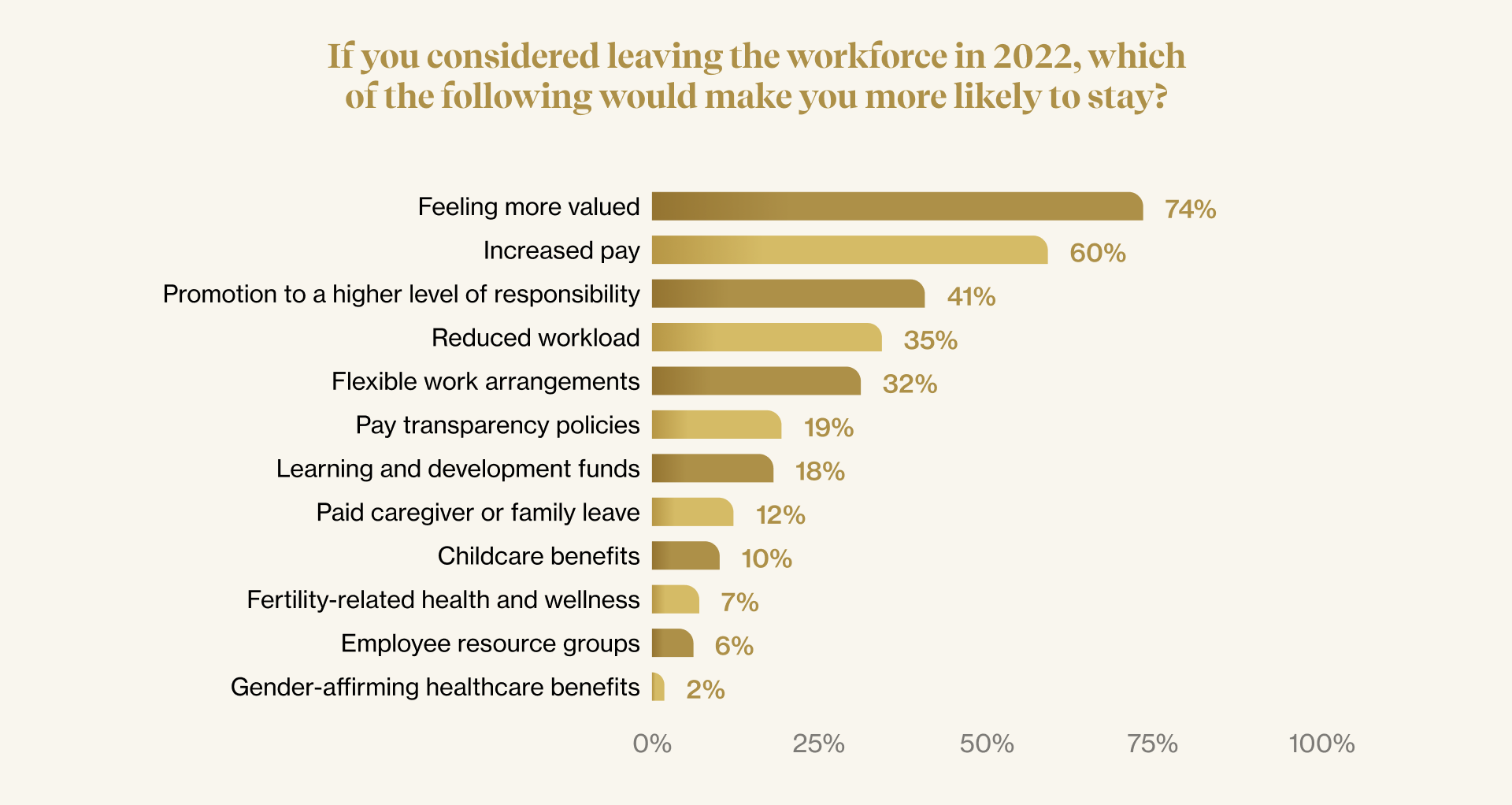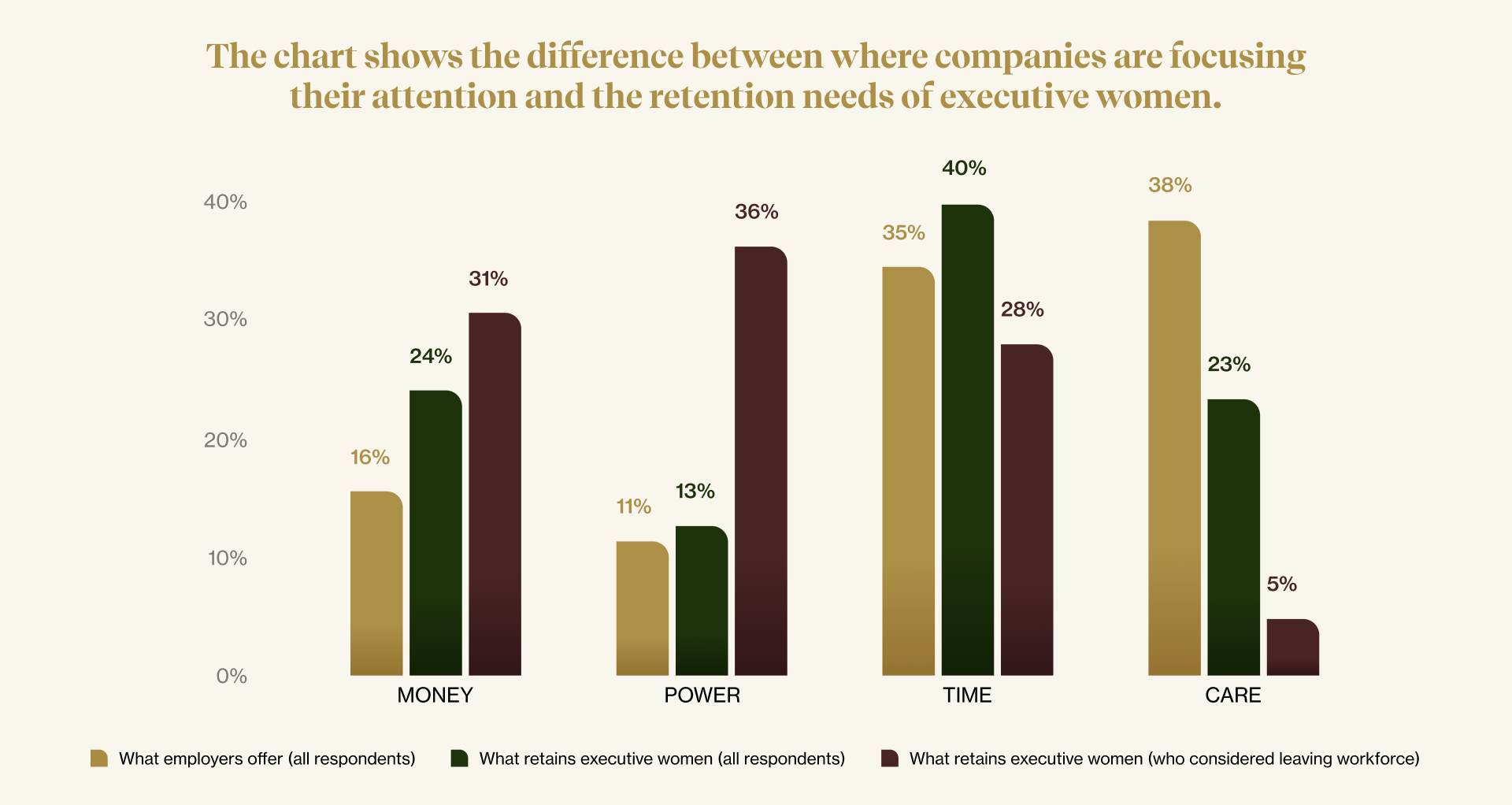When Jane* stepped into her last role three years ago as a senior executive at a financial services firm she was promised one key thing: a strong support staff. As a leader on the client-facing side of the business, she knew that the job would be high-touch but doable with the right team.
But roughly one month into her position, the pandemic hit, resulting in staff disruptions and mass exits. Then, Jane learned that she was expecting. Returning as a new mom to a support staff that never appeared, “it only got worse through Covid and it became less of something that I wanted to deal with as a parent,” she says. “But, the straw that broke the camel's back was in July.” Her partner got Covid, and then her father-in-law passed away. “That situation for us highlighted just how fragile our family ecosystem was and how unsustainable our jobs were as a unit.” As a result, Jane resigned.
Her decision to leave the workforce is something that many executive women have grappled with, especially over the past year. That’s according to Chief’s “Make Work Work” survey of 847 Chief Members, all of whom are at the VP level or above and who collectively manage $220 billion of the U.S. economy. Though these women hold positions of power at some of the world’s most influential companies, more than one-third said they considered leaving the workforce in 2022.
While many employers have implemented new workplace policies to keep top employees in place, Chief’s survey found that there’s a huge disconnect between what companies think women want at work versus what they actually need.

Credit: Frey Gordillo
Yes, flexible work arrangements and paid family leave are critical for retention, but according to Chief Members, they are now table stakes and ultimately aren’t enough for women to truly succeed.
When asking surveyed executives what would convince them to stay in the workforce, the top response was feeling more valued, followed by two of the most tangible manifestations of value: pay and promotion.
“Even when I felt the most qualified, I was passed over for a promotion,” one surveyed Chief Member said.
To better understand the disconnect between what employers offer at work versus what women leaders need, Chief identified 10 policies that are often used for retention and divided them into four categories: money, power, time, and care.
- Money: Policies designed to ensure employees receive fair financial compensation for their work effort, including pay transparency and learning and development funds.
- Power: Policies designed to empower employees in their career journeys, such as company sponsorship of networking opportunities.
- Time: Policies designed to help employees own and make the most of their time, including flexible work, paid caregiver or family leave, and childcare benefits.
- Care: Policies designed to help employees feel mentally and physically cared for in and beyond the workplace, including mental health coverage, fertility-related health and wellness benefits, employee resource groups, and gender-affirming healthcare benefits.

Credit: Frey Gordillo
Money
Companies are under-delivering on policies that ensure fair financial compensation, with women who considered leaving nearly twice as likely to say they desire money-related actions from their employer as their employers are to offer such policies. Clearly, the big missing piece here is pay transparency. Executive women are twice as likely to say they want this policy as they are to say that it is already in place.
Chief Member Iris Shaffer, SVP, North America Media Practice Lead at APCO Worldwide, says pay transparency is critical for her company’s success. “Our Chief Human Resources Officer actually explains how much women at the top are making versus men and what they're trying to do to close those gaps if they in fact exist,” she says.
In addition to enforcing fair pay, Shaffer says APCO Worldwide also has a re-entry program called Encore, which supports the advancement of caregivers who’ve taken a career break, most of whom are women. This on-ramp program, she says, allows employees who’ve taken a hiatus to come back to work on a part-time or full-time schedule with the necessary support and resources needed to succeed.
Learning and development funds are somewhat less impactful as a retention driver, but many respondents cited these funds as a way to break into the executive ranks.
“Education reimbursement allowed me to get an EMBA that was the catalyst for my promotion to VP," one surveyed Chief Member said.
Power
A lack of power is the top driver pushing executive women to consider leaving the workforce altogether, and companies are not doing enough to meet the need. Actions that target individual employees (e.g., promotions and pay raises) are critical considerations — but one-off efforts won’t go far enough.
Companies must set, and track progress against, representation goals. As one respondent said, “I would not be in my position if my current company, and others before, did not have targets on the number of women represented in roles and make it the responsibility of executives to meet diversity goals.” Another noted, “We started measuring DEI this year and are beginning to see how it moves the needle. Our promotion for women has increased by 40% and the percentage of women in leadership has increased from 12% to 18%.”
Companies should also sponsor networking opportunities that help women leverage and expand their power. Several respondents said that networking groups and events helped retain and grow them.
“Getting involved with industry associations and networking increased my organizational value and visibility. When you are able to establish a personal brand, it prevents women from becoming invisible," one surveyed Chief Member said.
For Chief Member Patrice Clark, VP at Vericon Construction, “It was a struggle for me to really advance my career,” she says. “I've always had to perform the work for quite some time before I could get them to put me into that next level position.”
For the first nine years of her career, Clark says she felt like she was at a standstill, leading her to take a two-year break to focus more on her family. Now, after being at her current company for almost nine years, the VP says she finally feels like she’s getting the career support that she had always needed.
Time & Care
Companies are significantly over-indexing on time and care-related policies — and yet, they are the least important retention driver for executive women, especially those that considered leaving the workforce. This discrepancy is likely due to the fact that adding such policies requires less structural change. In fact, just 32% of executive women say that a flexible work policy would get them to stay at a company, and 20% say mental health benefits would get them to do the same.
To be clear, flexible policies are still needed to make workplaces work for women. But, they’re not an end-all-be-all strategy for retention, especially if companies fall short on paying and promoting women fairly.
“Even though there are other frustrations for me at the company, the level of flexibility I have here has prevented me from leaving," one surveyed Chief Member said.
As it pertains to caregiving policies, companies still have room to grow as only 13% of those surveyed said their companies provide childcare benefits. Companies who want to lead in this space should consider offering not just financial compensation, but also direct support for locating childcare. Several respondents said they experienced significant challenges locating childcare during and after COVID.
“I spent seven years on a flexible work arrangement so that I could be home with my children when they were younger. I wouldn’t have stayed in public accounting if this hadn’t been an option," one surveyed Chief Member said.
Companies Need a Diverse and Evolving Portfolio of Policies to Retain Women Leaders
As the data shows, needs vary among executive women who have considered leaving the workforce and those who have not (yet), so companies should strive for a balanced policy portfolio that encompasses money, power, time, and care. Perhaps most important, it is up to leaders across the organizational structure to ensure these policies translate into lived realities.
“From my perspective, it’s less about policies and more about practices. Many supportive practices can be in place without (or in spite of) policies,” one surveyed Chief Member said.
*Editor’s Note: Out of request for anonymity, we’ve changed the name for one of the subjects in this story.
